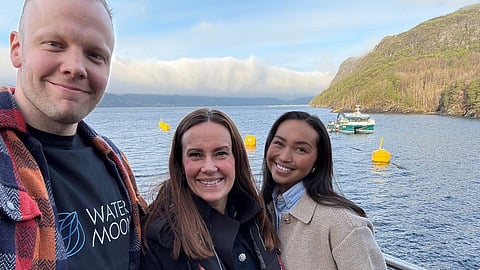

Eide Fjordbruk CEO Sondre Eide, pictured with Minister of Fisheries Marianne Sivertsen Næss and Eide Lead Engineer, Maria Danielsen.
Photo: Sondre Eide.
Norwegian family-owned salmon farming company Eide Fjordbruk has announced it will be launching an updated version of its proprietary "Watermoon" floating closed containment aquaculture system later this year, which it describes as "a technology made by fish farmers, for fish farmers".
The company reports it has completed a successful pilot project for its innovative closed containment technology, producing salmon with no sea lice, in addition to collecting sludge at a rate similar to land-based facilities.
Now, CEO Sondre Eide believes the technology is ready to be deployed for large-scale operation, with four new Watermoon version 2.0 systems ordered and due to be in place in the sea before the end of the year.
"We are pleased with the results of the Watermoon project. We have had 200,000 fish, completely free of lice or the need for delousing, which ensures better fish welfare and opportunities for increased production. The sludge collection rate is on par with, or higher than, the best land-based facilities, and the quality of the fish in the facility has been very good," Eide said in a press release.
The company says it has been conducting "stress tests" on its technology in order to prepare for scaling up, which it acknowledges will be "far more demanding than our previous small-scale pilots".
As a result of this research and development, Eide states that Watermoon 2.0 will feature improvements including better biological control, a new design intended for operation in more weather-exposed areas, and improved cleaning functions that reduce the risk of human error.
"We will never stop innovating, but with the zero-discharge technology Watermoon version 2.0 we are taking another big step forward," Sondre Eide said, explaining that he, together with key employees in the company, intend to "dedicate all their time to Watermoon".
"I don't think there are many other technologies that have been tested as thoroughly on such a large scale as Watermoon. When we are going to invest in production with zero-discharge technology, it is important to know as much as possible in advance – and we are doing that now," he said.
Eide added he is also looking forward to the Norwegian government's forthcoming aquaculture report, in which the government has signalled a focus on zero-discharge technology.
The company recently hosted a visit from Norwegian fisheries minister, Marianne Sivertsen Næss. The Ministry recently proposed that aquaculture operators whose production capacity has been reduced under Norway's "traffic light" aquaculture zoning system could compensate for this by utilizing zero-discharged closed aquaculture facilities.
"It is positive that the government is signaling new incentives for environmentally friendly technology. I think the minister was clear about the direction she wanted. Now the Storting and the government must follow up when the aquaculture report comes," Eide stated.
"We at Eide think it's great to be able to farm fish completely free of lice, and it was great for us to show the Watermoon technology to the minister. We're taking the politicians at their word and investing everything now so that we can solve the lice problem, improve fish welfare and reduce our footprint. We're simply ready," he added.
